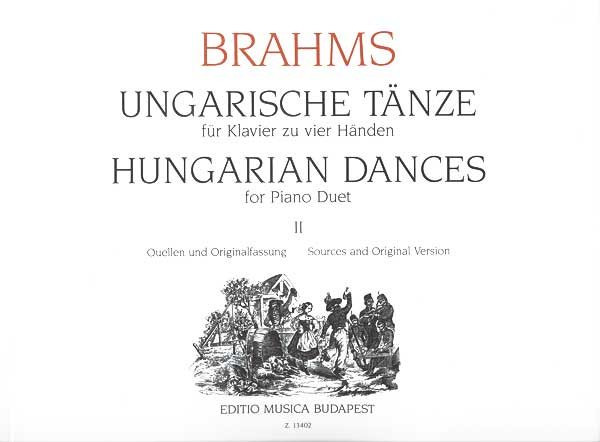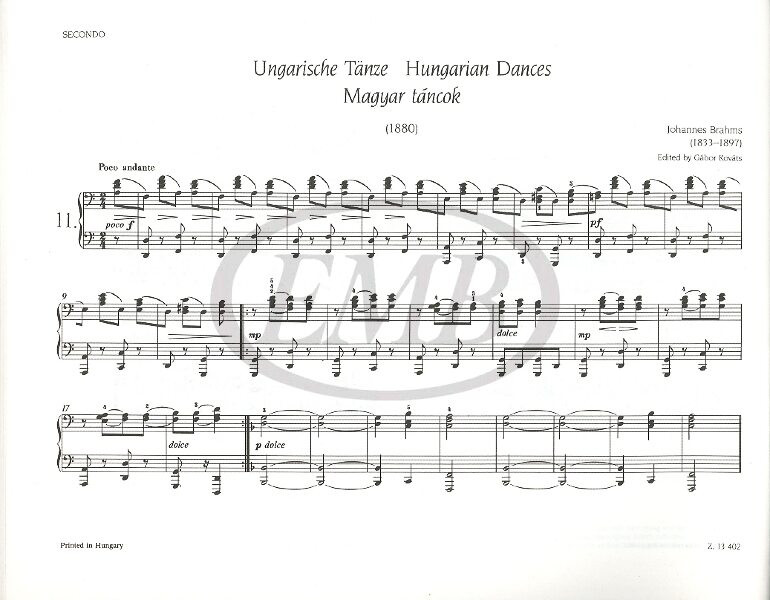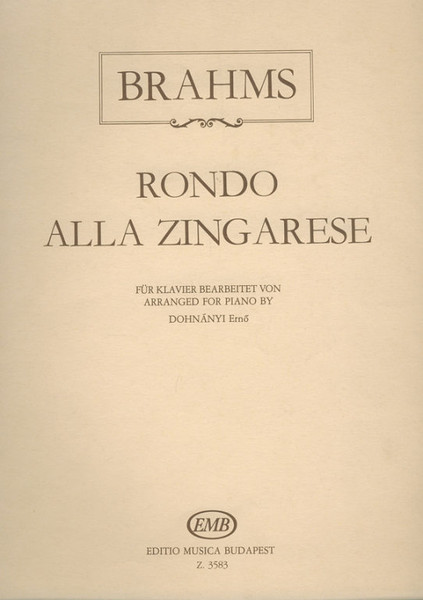Description
Romantic Fire: Brahms' Hungarian Dances Volume 2 for Piano Duet
Product Details
- Product Type: Sheet Music / Piano Duet Score (Zongora négykezes)
- ISMN: 9790080134023 / 979-0080134023
- Item Number (MPN): 13402
- Brand/Publisher: Editio Musica Budapest Zeneműkiadó
- Composer: Johannes Brahms
- Editors: Gábor Kováts, Katalin Szerző
- Instrumentation: Piano, Four Hands (Duet)
- Period/Genre: Romantic / Hungarian Dance / Folk-Inspired
- Title in Hungarian: Magyar táncok 2
- Binding: Paperback
- Made in: Hungary
- Year of Publication: 1991
- Pages: 72 pages
- Format: Bach Quer (30.2 x 23 cm) – Horizontal score format
Overview
This volume features the second half of Johannes Brahms’s universally popular Hungarian Dances (Magyar táncok 2), presenting pieces 11 through 21 in their original, intended setting for Piano Duet (Zongora négykezes). Edited by Gábor Kováts and Katalin Szerző, this edition is a treasure trove of Hungarian-style musical elements, including verbunkos (recruiting songs), csárdás, folk songs, and folk-style art songs. These works immediately brought Brahms international recognition and remain essential repertoire for intermediate and advanced duets, celebrating the blend of German Romanticism and Hungarian musical idioms.
Áttekintés (Hungarian)
Ez a kötet Johannes Brahms univerzálisan népszerű Magyar táncainak (Magyar táncok 2) második felét tartalmazza, bemutatva a 11-től 21-ig terjedő darabokat eredeti, szándékolt formájukban, zongora négykezesre írva. Kováts Gábor és Szerző Katalin szerkesztésében ez a kiadvány a magyaros zenei elemek gazdag tárháza, beleértve a verbunkost, a csárdást, a népdalokat és a népies műdalokat. Ezek a művek azonnali nemzetközi elismerést hoztak Brahmsnak, és alapvető repertoárdarabok maradtak a középhaladó és haladó zongora-duettek számára, ünnepelve a német romantika és a magyar zenei nyelvezet ötvözését.
Product Features
- Format: Bach Quer (Horizontal) – The ideal layout for Piano Duet scores, where two performers read from the same wide volume.
- Length: 72 pages, containing Dances 11 through 21 of the cycle.
- Instrumentation: Written specifically for Piano, Four Hands, preserving the texture and effect Brahms originally conceived.
- Unique Feature: This EMB publication includes facsimile excerpts from 19th-century Hungarian publications that may have served as Brahms's original source material, offering valuable musicological context.
Interesting Facts
Johannes Brahms (1833–1897) had deep personal and professional ties to the Hungarian music scene, including friendships with violinist József Joachim and conductor Ede Reményi. Brahms based the Hungarian Dances on existing melodies, primarily those associated with the then-popular verbunkos and csárdás styles, which he heard and collected.
Although not technically original compositions, the Dances are pure Brahms in their harmonic richness and structural arrangement. The original composition for piano four-hands highlights the interplay between the two performers, capturing the improvisatory, raw energy of the source material better than many subsequent solo transcriptions. Volume 2, published in 1880, completed the cycle and cemented the work's status as a Romantic classic.
Érdekességek (Hungarian)
Johannes Brahms (1833–1897) mély személyes és szakmai kapcsolatokkal rendelkezett a magyar zenei élethez, beleértve Joachim József hegedűművésszel és Reményi Ede karmesterrel kötött barátságát. Brahms a Magyar táncokat meglévő dallamokra alapozta, elsősorban az akkor népszerű verbunkos és csárdás stílusokhoz köthető melódiákra, amelyeket hallott és gyűjtött.
Bár technikailag nem eredeti kompozíciók, a Táncok tisztán Brahmsot tükröznek harmonikus gazdagságukban és szerkezeti elrendezésükben. Az eredeti zongora négykezesre írt kompozíció kiemeli a két előadó közötti kölcsönhatást, jobban megragadva a forrásanyag improvizatív, nyers energiáját, mint a későbbi szólóátiratok. Az 1880-ban megjelent 2. kötet fejezte be a ciklust, és megerősítette a mű státuszát, mint romantikus klasszikus.
Publishers
Editio Musica Budapest Zeneműkiadó Editio Musica Budapest (EMB) is renowned for its authoritative editions of works with Central European ties. This Piano Duet score is a high-quality pedagogical tool, essential for students and performers of Romantic chamber music seeking authentic and scholarly sources.
We value your feedback! Share your experience with this product to help others make informed decisions. Your review is important to us!
Hashtags
#BrahmsHungarianDances #MagyarTáncok #PianoDuet #ZongoraNégykezes #RomanticRepertoire #FolkInspiredMusic #EditioMusicaBudapest #KovátsSzerző #Verbunkos #Csárdás #Piano4Hands



















